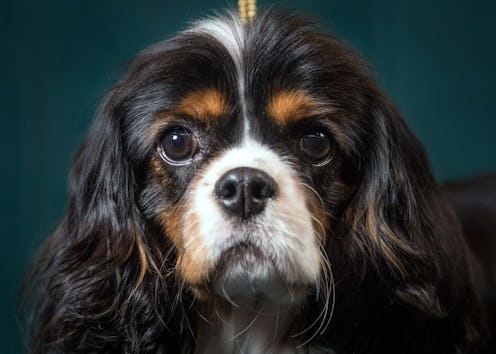Life
7 Dog Breeds That Royals Have Always Been Obsessed With (Other Than Corgis)

Dogs and royals have a very long joint history. Whether hounds have been appearing in ceremonies, guarding their imperial owners, going on hunts, or snuggling in the royal lap, they've been a strong part of royal life all over the world for centuries. Royal dog breeds from history run the gamut: There's evidence that the ancient Egyptian imperial class owned salukis and esteemed them as the highest form of dog, but every ruler has had their own favorites. Everybody knows about Queen Elizabeth II's corgis — she was given her first one by her father when she turned 18, and has had some in the royal palaces of England ever since — but there's a lot more to dogs in royal courts than those little floofers.
Dogs have often reflected the needs and traditions of their royal owners, demonstrating strength, wealth, luxury or loyalty. They've also been diplomatic gifts that have bonded countries together: Prince Albert brought a pair of greyhounds when he came from Germany to marry Queen Victoria in 1840. Nobody can say no to a puppy. With news that Duchess Meghan and Prince Harry have adopted a dog of their own, a Labrador retriever, there's no chance of the royal dog tradition slowing up any time soon. Here are seven dog breeds royals have historically been obsessed with.
1Akitas
The Akita Inu breed originated in Japan, and these big dogs with proud temperaments are known to have been favorites with the Japanese imperial elite over several centuries. In the Edo period of the 17th and 18th centuries, Akitas were only allowed to be owned by shoguns for the purpose of hunting bears and other large game. The Emperor Taisho was photographed with his own Akitas in 1899, and the breed was declared of national importance and became available for everybody in the early 20th century.
2Beagles
The history of the beagle is studded with royalty, because they've been bred to be excellent hunting dogs. Their ancestors were likely brought to England by William the Conqueror following the Norman Conquest in 1066, and it's been reported that King Henry VII of England kept "glove beagles," beagles so small that they could fit into the palm of a leather glove, for hunting.
3Toy Spaniels
Toy spaniels, like the Cavalier King Charles Spaniel, have been popular with European royalty since at least Tudor times, but were particularly popular among the Stuart kings; King Charles II loved them, and they show up in a lot of royal paintings. Later, Queen Victoria's most beloved pet was her spaniel Dash, given to her at the age of 17, and when he died his epitaph read: "His attachment was without selfishness, His playfulness without malice, His fidelity without deceit, READER, if you would live beloved and die regretted, profit by the example of DASH."
4Labrador Retrievers
Queen Elizabeth II's father, King George VI, loved big hunting dogs, and was particularly fond of Labrador retrievers. He started to breed them at the royal estates in Sandringham and Balmoral in 1911, and treated them both as working dogs and as pets. Labradors have remained part of the royal household of hunting dogs at the estates ever since, and won a lot of awards for their skill.
5Bichon Frise
The American Kennel Club calls the bichon frise "the royal lap warmer", and they're not wrong. These little white fluffballs began to be adopted by European royalty in the 13th century and show up in portraits of royal women, men and children for centuries, often fabulously attired. It's reported that King Henry III of France loved them so much that he kept a few around his neck in a little ribbon-adorned basket.
6Shih Tzu
The Shih Tzu has been bred throughout history to be a "lion dog" resembling the big cat, which has been a big factor in its appeal to Chinese royalty. They've often been symbolic gifts to the imperial leaders of China. The Dowager Empress Tzu Hsi, who ruled China from the end of the 19th century to the beginning of the 20th, was a particular fan, but their imperial history reaches back many dynasties, according to Pedigree. In some periods they were apparently carried in the sleeves of Chinese royalty and non-imperial owners could be punished by death.
7Great Pyrenees
The Great Pyrenees, despite its status as a strong working dog, is also known as the "royal dog of France" because of its long streak of importance to French royalty. They were discovered by French nobility in the 17th century and adopted as guard dogs for the chateaux and elaborate palaces of the period. Louis XIV loved them so much he declared them the "royal dog" in 1675.
8
If you ever have to ingratiate yourself with a royal somewhere, maybe just start talking about dogs. They've had a long history together.